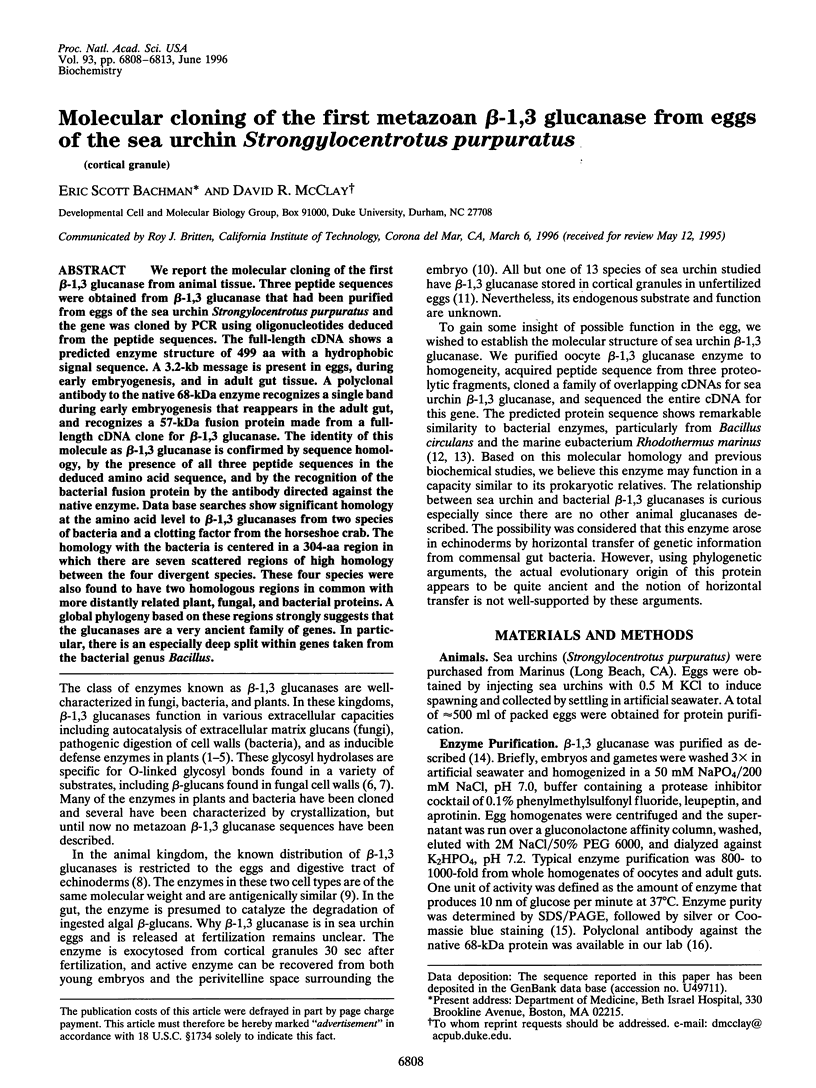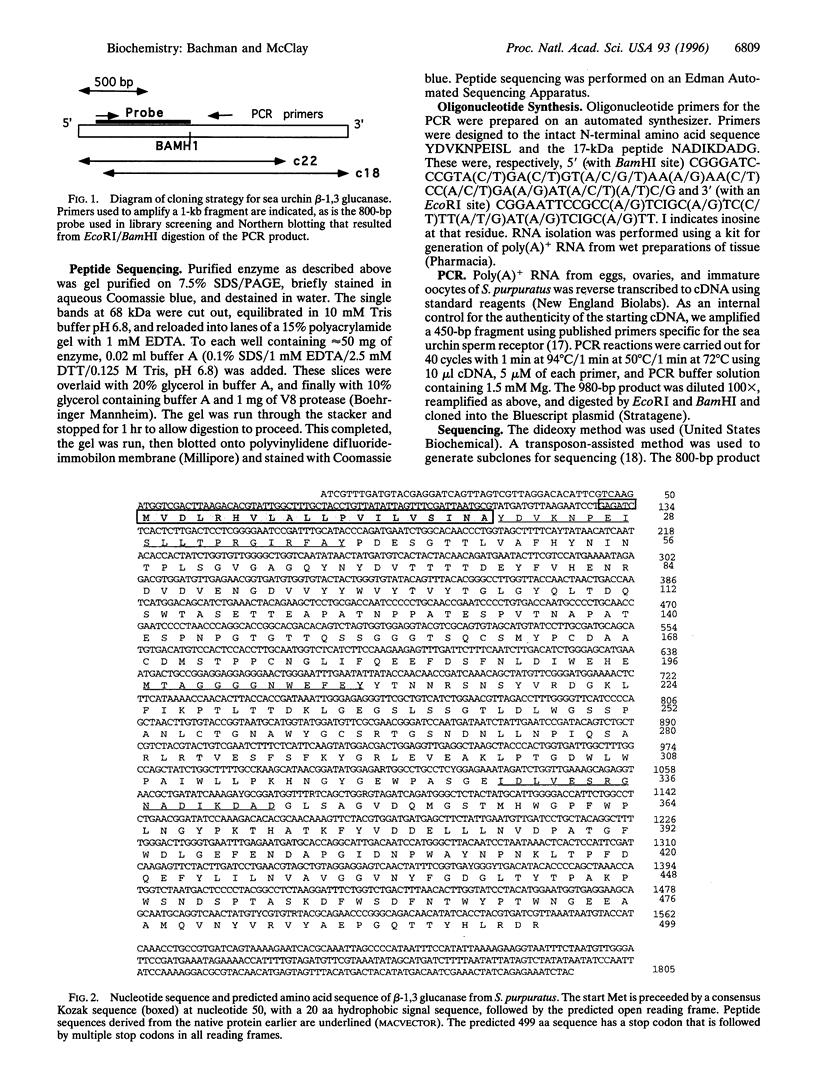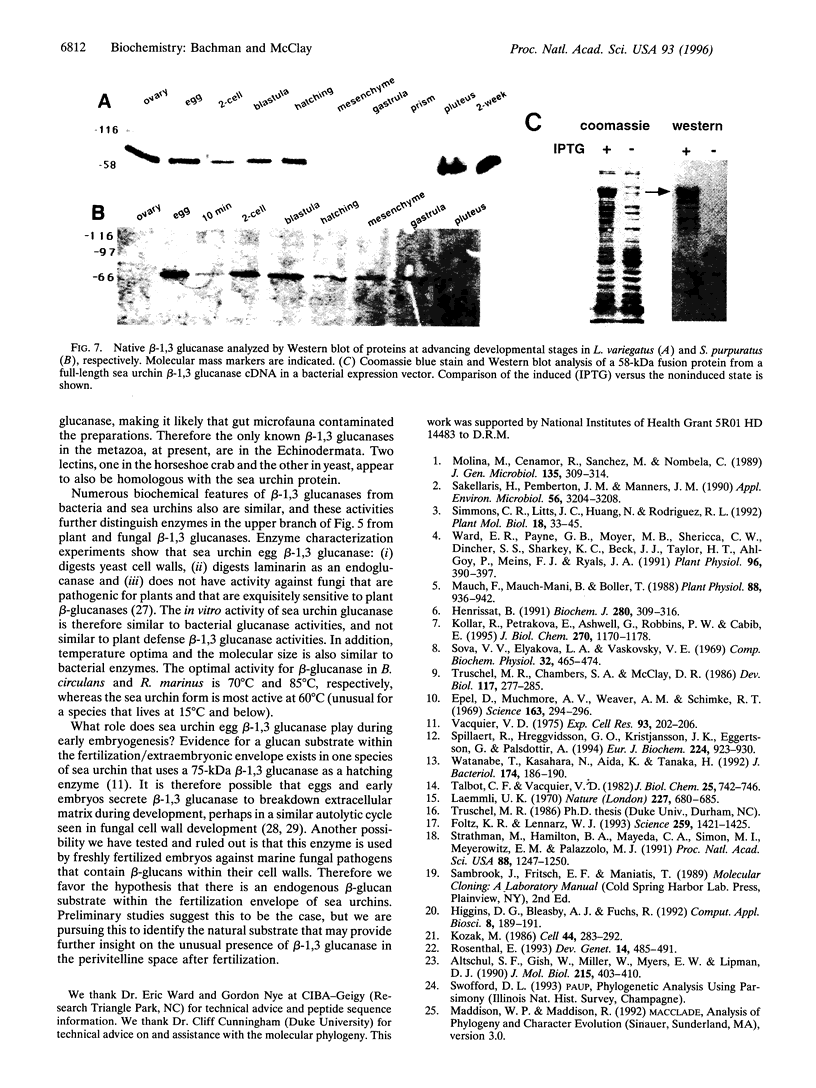Abstract
We report the molecular cloning of the first beta-1,3 glucanase from animal tissue. Three peptide sequences were obtained from beta-1,3 glucanase that had been purified from eggs of the sea urchin Strongylocentrotus purpuratus and the gene was cloned by PCR using oligonucleotides deduced from the peptide sequences. The full-length cDNA shows a predicted enzyme structure of 499 aa with a hydrophobic signal sequence. A 3.2-kb message is present in eggs, during early embryogenesis, and in adult gut tissue. A polyclonal antibody to the native 68-kDa enzyme recognizes a single band during early embryogenesis that reappears in the adult gut, and recognizes a 57-kDa fusion protein made from a full-length cDNA clone for beta-1,3 glucanase. The identity of this molecule as beta-1,3 glucanase is confirmed by sequence homology, by the presence of all three peptide sequences in the deduced amino acid sequence, and by the recognition of the bacterial fusion protein by the antibody directed against the native enzyme. Data base searches show significant homology at the amino acid level to beta-1,3 glucanases from two species of bacteria and a clotting factor from the horseshoe crab. The homology with the bacteria is centered in a 304-aa region in which there are seven scattered regions of high homology between the four divergent species. These four species were also found to have two homologous regions in common with more distantly related plant, fungal, and bacterial proteins. A global phylogeny based on these regions strongly suggests that the glucanases are a very ancient family of genes. In particular, there is an especially deep split within genes taken from the bacterial genus Bacillus.
Full text
PDF





Images in this article
Selected References
These references are in PubMed. This may not be the complete list of references from this article.
- Altschul S. F., Gish W., Miller W., Myers E. W., Lipman D. J. Basic local alignment search tool. J Mol Biol. 1990 Oct 5;215(3):403–410. doi: 10.1016/S0022-2836(05)80360-2. [DOI] [PubMed] [Google Scholar]
- Epel D., Weaver A. M., Muchmore A. V., Schimke R. T. Beta-1,3-glucanase of sea urchin eggs: release from particles at fertilization. Science. 1969 Jan 17;163(3864):294–296. doi: 10.1126/science.163.3864.294. [DOI] [PubMed] [Google Scholar]
- Foltz K. R., Partin J. S., Lennarz W. J. Sea urchin egg receptor for sperm: sequence similarity of binding domain and hsp70. Science. 1993 Mar 5;259(5100):1421–1425. doi: 10.1126/science.8383878. [DOI] [PubMed] [Google Scholar]
- Henrissat B. A classification of glycosyl hydrolases based on amino acid sequence similarities. Biochem J. 1991 Dec 1;280(Pt 2):309–316. doi: 10.1042/bj2800309. [DOI] [PMC free article] [PubMed] [Google Scholar]
- Higgins D. G., Bleasby A. J., Fuchs R. CLUSTAL V: improved software for multiple sequence alignment. Comput Appl Biosci. 1992 Apr;8(2):189–191. doi: 10.1093/bioinformatics/8.2.189. [DOI] [PubMed] [Google Scholar]
- Keitel T., Simon O., Borriss R., Heinemann U. Molecular and active-site structure of a Bacillus 1,3-1,4-beta-glucanase. Proc Natl Acad Sci U S A. 1993 Jun 1;90(11):5287–5291. doi: 10.1073/pnas.90.11.5287. [DOI] [PMC free article] [PubMed] [Google Scholar]
- Kollár R., Petráková E., Ashwell G., Robbins P. W., Cabib E. Architecture of the yeast cell wall. The linkage between chitin and beta(1-->3)-glucan. J Biol Chem. 1995 Jan 20;270(3):1170–1178. doi: 10.1074/jbc.270.3.1170. [DOI] [PubMed] [Google Scholar]
- Kozak M. Point mutations define a sequence flanking the AUG initiator codon that modulates translation by eukaryotic ribosomes. Cell. 1986 Jan 31;44(2):283–292. doi: 10.1016/0092-8674(86)90762-2. [DOI] [PubMed] [Google Scholar]
- Laemmli U. K. Cleavage of structural proteins during the assembly of the head of bacteriophage T4. Nature. 1970 Aug 15;227(5259):680–685. doi: 10.1038/227680a0. [DOI] [PubMed] [Google Scholar]
- Mauch F., Mauch-Mani B., Boller T. Antifungal Hydrolases in Pea Tissue : II. Inhibition of Fungal Growth by Combinations of Chitinase and beta-1,3-Glucanase. Plant Physiol. 1988 Nov;88(3):936–942. doi: 10.1104/pp.88.3.936. [DOI] [PMC free article] [PubMed] [Google Scholar]
- Molina M., Cenamor R., Sanchez M., Nombela C. Purification and some properties of Candida albicans exo-1,3-beta-glucanase. J Gen Microbiol. 1989 Feb;135(Pt 2):309–314. doi: 10.1099/00221287-135-2-309. [DOI] [PubMed] [Google Scholar]
- Planas A., Juncosa M., Lloberas J., Querol E. Essential catalytic role of Glu134 in endo-beta-1,3-1,4-D-glucan 4-glucanohydrolase from B. licheniformis as determined by site-directed mutagenesis. FEBS Lett. 1992 Aug 17;308(2):141–145. doi: 10.1016/0014-5793(92)81262-k. [DOI] [PubMed] [Google Scholar]
- Rosenthal E. Sequence analysis of translationally controlled maternal mRNAs from Urechis caupo. Dev Genet. 1993;14(6):485–491. doi: 10.1002/dvg.1020140609. [DOI] [PubMed] [Google Scholar]
- Sakellaris H., Pemberton J. M., Manners J. M. Genes from Cellvibrio mixtus encoding beta-1,3 endoglucanase. Appl Environ Microbiol. 1990 Oct;56(10):3204–3208. doi: 10.1128/aem.56.10.3204-3208.1990. [DOI] [PMC free article] [PubMed] [Google Scholar]
- Simmons C. R., Litts J. C., Huang N., Rodriguez R. L. Structure of a rice beta-glucanase gene regulated by ethylene, cytokinin, wounding, salicylic acid and fungal elicitors. Plant Mol Biol. 1992 Jan;18(1):33–45. doi: 10.1007/BF00018454. [DOI] [PubMed] [Google Scholar]
- Spilliaert R., Hreggvidsson G. O., Kristjansson J. K., Eggertsson G., Palsdottir A. Cloning and sequencing of a Rhodothermus marinus gene, bglA, coding for a thermostable beta-glucanase and its expression in Escherichia coli. Eur J Biochem. 1994 Sep 15;224(3):923–930. doi: 10.1111/j.1432-1033.1994.00923.x. [DOI] [PubMed] [Google Scholar]
- Strathmann M., Hamilton B. A., Mayeda C. A., Simon M. I., Meyerowitz E. M., Palazzolo M. J. Transposon-facilitated DNA sequencing. Proc Natl Acad Sci U S A. 1991 Feb 15;88(4):1247–1250. doi: 10.1073/pnas.88.4.1247. [DOI] [PMC free article] [PubMed] [Google Scholar]
- Talbot C. F., Vacquier V. D. The purification and characterization of an exo-beta (1 going to 3)-glucanohydrolase from sea urchin eggs. J Biol Chem. 1982 Jan 25;257(2):742–746. [PubMed] [Google Scholar]
- Turkiewicz M., Kalinowska H., Galas E. An endo-(1----3)-beta-glucanase and a collagenolytic serine proteinase from Euphausia superba Dana (Antarctic krill). Acta Biochim Pol. 1991;38(1):79–85. [PubMed] [Google Scholar]
- Vacquier V. D. The appearance of beta-1,3-glucanase in hatching embryos of the sea urchin, Echinometra vanbrunti. Exp Cell Res. 1975 Jun;93(1):202–206. doi: 10.1016/0014-4827(75)90440-1. [DOI] [PubMed] [Google Scholar]
- Ward E. R., Payne G. B., Moyer M. B., Williams S. C., Dincher S. S., Sharkey K. C., Beck J. J., Taylor H. T., Ahl-Goy P., Meins F. Differential Regulation of beta-1,3-Glucanase Messenger RNAs in Response to Pathogen Infection. Plant Physiol. 1991 Jun;96(2):390–397. doi: 10.1104/pp.96.2.390. [DOI] [PMC free article] [PubMed] [Google Scholar]
- Watanabe T., Kasahara N., Aida K., Tanaka H. Three N-terminal domains of beta-1,3-glucanase A1 are involved in binding to insoluble beta-1,3-glucan. J Bacteriol. 1992 Jan;174(1):186–190. doi: 10.1128/jb.174.1.186-190.1992. [DOI] [PMC free article] [PubMed] [Google Scholar]
- Wessel G. M., Truschel M. R., Chambers S. A., McClay D. R. A cortical granule-specific enzyme, B-1,3-glucanase, in sea urchin eggs. Gamete Res. 1987 Dec;18(4):339–348. doi: 10.1002/mrd.1120180408. [DOI] [PubMed] [Google Scholar]





